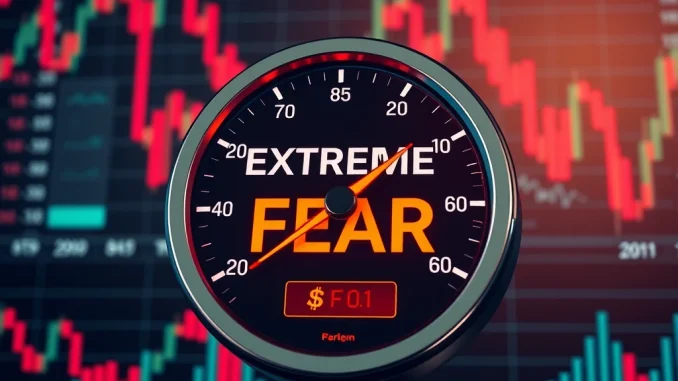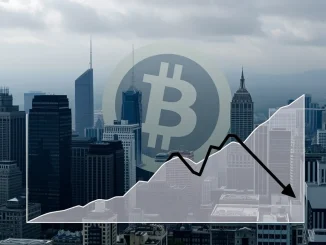
Is the cryptocurrency market still gripped by fear? The latest readings from the Crypto Fear and Greed Index suggest exactly that. While inching up slightly, the index remains firmly entrenched in the ‘Extreme Fear’ zone, signaling deep-seated anxiety among crypto investors. Let’s delve into what this means and how you can interpret this crucial market indicator.
Understanding the Crypto Fear and Greed Index
The Crypto Fear and Greed Index is a powerful tool designed to gauge market sentiment. Think of it as a mood ring for the crypto market, reflecting the prevailing emotions of investors. Created by Alternative.me, this index operates on a scale from 0 to 100. Here’s a quick breakdown:
- 0-25: Extreme Fear – This zone indicates that investors are excessively worried. It often suggests a potential buying opportunity as prices might be undervalued due to panic selling.
- 26-49: Fear – Still leaning towards caution, but slightly less intense than ‘Extreme Fear’. Investors are hesitant and risk-averse.
- 50-75: Greed – Optimism starts to creep in. Investors are becoming more confident and willing to take risks, potentially leading to market rallies.
- 76-100: Extreme Greed – This is when euphoria sets in. Investors are overly enthusiastic, often leading to speculative bubbles and increased risk of market corrections.
Currently, the index sits at 24, a minor increase of one point from the previous day, but still firmly within the Extreme Fear Crypto territory. This persistent fear raises important questions about the current state and future direction of the crypto market.
What Factors Drive the Fear and Greed Index?
To provide a comprehensive view of market sentiment, the Crypto Fear and Greed Index considers six key factors, each weighted to reflect its influence on overall market psychology:
- Volatility (25%): Measures the current and maximum drawdowns of Bitcoin, comparing it with the average values over the last 30 and 90 days. Unusual volatility is often a sign of fear.
- Market Momentum/Volume (25%): Examines the current market momentum and trading volume compared to the past 30 and 90-day averages. High buying volume signals greed, while low volume during price drops can indicate fear.
- Social Media (15%): Primarily analyzes sentiment on Twitter, focusing on crypto-related hashtags. High positive interaction suggests greed, while negative sentiment points towards fear.
- Surveys (15%): Conducts weekly crypto polls to gauge investor sentiment. While currently paused, this factor traditionally provided direct insights into market participants’ feelings.
- Bitcoin Dominance (10%): Tracks Bitcoin’s dominance in the overall crypto market. Increased Bitcoin dominance can sometimes indicate a ‘flight to safety’ during fearful times, as investors move away from riskier altcoins.
- Google Trends (10%): Analyzes Google Trends data for Bitcoin-related search queries. Surges in searches like “Bitcoin price manipulation” often correlate with market fear.
By aggregating these diverse data points, the index provides a holistic snapshot of the prevailing Crypto Market Sentiment.
Why is the Market Still in Extreme Fear?
Despite minor price fluctuations and occasional green candles, the overarching sentiment remains fear-driven. Several factors could contribute to this persistent Bitcoin Fear Index reading:
- Macroeconomic Uncertainty: Global economic conditions, including inflation, interest rate hikes, and geopolitical tensions, heavily influence investor sentiment across all markets, including crypto.
- Regulatory Scrutiny: Ongoing regulatory discussions and actions around cryptocurrencies create uncertainty and can dampen investor enthusiasm.
- Market Corrections: Recent market corrections and price drops can leave lasting psychological impacts, making investors wary of further dips.
- Negative News Cycles: Persistent negative news coverage, be it hacks, scams, or market crashes, can fuel fear and distrust in the crypto space.
Navigating Extreme Fear: Opportunities and Cautions
While ‘Extreme Fear’ might sound alarming, it’s crucial to understand how to interpret and potentially leverage this market condition:
| Scenario | Interpretation | Actionable Insight |
|---|---|---|
| Extreme Fear Persists | Market sentiment is highly negative; investors are risk-averse. | Potentially a buying opportunity for long-term investors if you believe in the fundamental value of crypto assets. |
| Fear Index Starts to Rise | Sentiment is slowly improving; fear is receding. | Monitor for confirmation of trend reversal before making significant moves. Could be the start of a recovery. |
| Index Moves into Greed/Extreme Greed | Market sentiment is overly optimistic; potential for a bubble. | Exercise caution, consider taking profits, and manage risk carefully. |
It’s important to remember that the Crypto Fear and Greed Index is just one tool among many. It shouldn’t be used in isolation but rather as part of a broader analysis that includes fundamental research, technical analysis, and personal risk assessment. Understanding Market Volatility and sentiment is key to making informed decisions in the dynamic crypto market.
Conclusion: Decoding Market Anxiety with the Fear & Greed Index
The Crypto Fear and Greed Index provides valuable insights into the emotional landscape of the cryptocurrency market. The current ‘Extreme Fear’ reading, while slightly improved, underscores the prevailing anxiety among investors. By understanding the factors driving this index and how to interpret its signals, you can better navigate the volatility and make more informed decisions in your crypto journey. Keep a close eye on this index as a pulse check on market sentiment, but always combine it with your own research and due diligence. Will fear persist, or will we see a shift towards greed? Only time will tell, but the Fear & Greed Index will undoubtedly continue to be a crucial indicator to watch.



